PS 313: Healthcare Policy in Sweden: Goals, Outcomes, and Challenges
VerifiedAdded on 2022/10/06
|8
|1698
|16
Report
AI Summary
This report provides a comprehensive overview of healthcare policy in Sweden, examining its goals, administration, and funding mechanisms. It delves into the three administrative levels of government involved in healthcare provision: national, regional, and local. The report highlights key policy issues, such as the aging population and patient safety, and discusses the outcomes of implemented policies, including improvements in healthcare access and cost-effectiveness. Strengths of the Swedish healthcare system, such as its universal coverage and cost-effectiveness, are analyzed alongside weaknesses, like long waiting times. The report concludes with recommendations for improving care coordination, especially for patients with complex health needs and the elderly, emphasizing the need for shared visions and quality assurance standards across regions. The report also references relevant literature and provides a detailed analysis of the Swedish healthcare model.

Name of student:
Registration number:
Unit Title:
Unit Code:
Name of supervisor:
Date due:
Word count:
Registration number:
Unit Title:
Unit Code:
Name of supervisor:
Date due:
Word count:
Paraphrase This Document
Need a fresh take? Get an instant paraphrase of this document with our AI Paraphraser

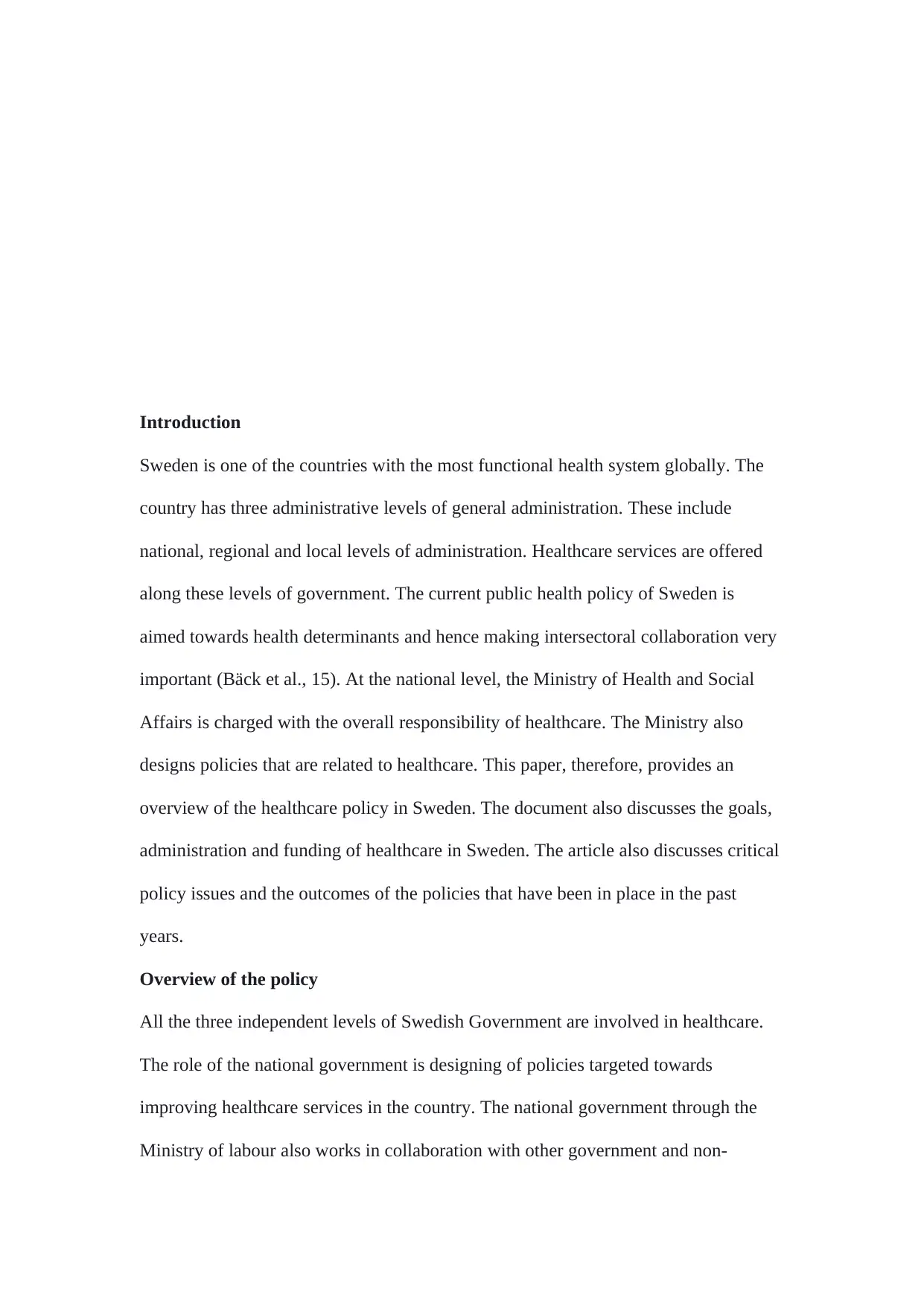
Introduction
Sweden is one of the countries with the most functional health system globally. The
country has three administrative levels of general administration. These include
national, regional and local levels of administration. Healthcare services are offered
along these levels of government. The current public health policy of Sweden is
aimed towards health determinants and hence making intersectoral collaboration very
important (Bäck et al., 15). At the national level, the Ministry of Health and Social
Affairs is charged with the overall responsibility of healthcare. The Ministry also
designs policies that are related to healthcare. This paper, therefore, provides an
overview of the healthcare policy in Sweden. The document also discusses the goals,
administration and funding of healthcare in Sweden. The article also discusses critical
policy issues and the outcomes of the policies that have been in place in the past
years.
Overview of the policy
All the three independent levels of Swedish Government are involved in healthcare.
The role of the national government is designing of policies targeted towards
improving healthcare services in the country. The national government through the
Ministry of labour also works in collaboration with other government and non-
Sweden is one of the countries with the most functional health system globally. The
country has three administrative levels of general administration. These include
national, regional and local levels of administration. Healthcare services are offered
along these levels of government. The current public health policy of Sweden is
aimed towards health determinants and hence making intersectoral collaboration very
important (Bäck et al., 15). At the national level, the Ministry of Health and Social
Affairs is charged with the overall responsibility of healthcare. The Ministry also
designs policies that are related to healthcare. This paper, therefore, provides an
overview of the healthcare policy in Sweden. The document also discusses the goals,
administration and funding of healthcare in Sweden. The article also discusses critical
policy issues and the outcomes of the policies that have been in place in the past
years.
Overview of the policy
All the three independent levels of Swedish Government are involved in healthcare.
The role of the national government is designing of policies targeted towards
improving healthcare services in the country. The national government through the
Ministry of labour also works in collaboration with other government and non-
⊘ This is a preview!⊘
Do you want full access?
Subscribe today to unlock all pages.

Trusted by 1+ million students worldwide
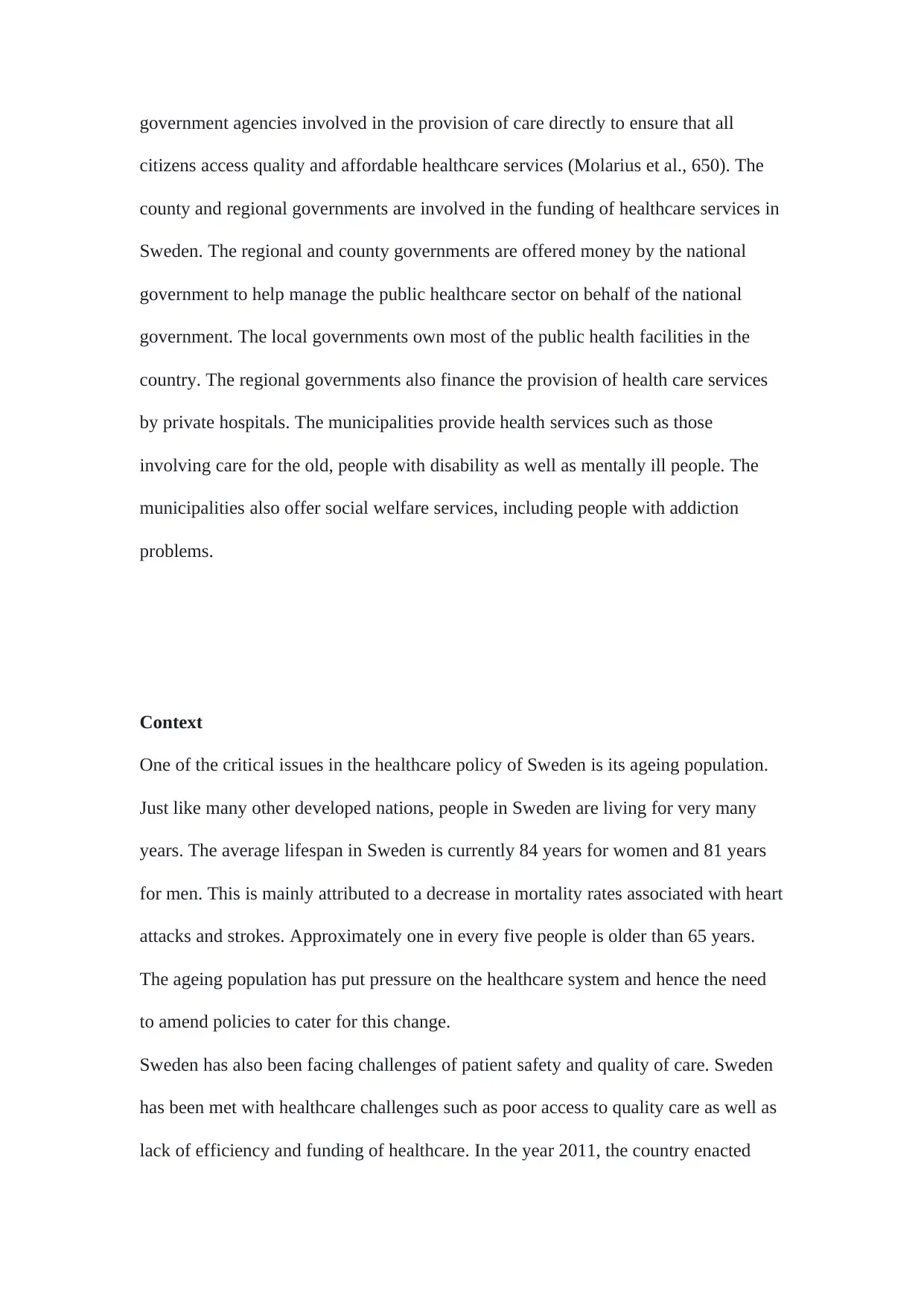
government agencies involved in the provision of care directly to ensure that all
citizens access quality and affordable healthcare services (Molarius et al., 650). The
county and regional governments are involved in the funding of healthcare services in
Sweden. The regional and county governments are offered money by the national
government to help manage the public healthcare sector on behalf of the national
government. The local governments own most of the public health facilities in the
country. The regional governments also finance the provision of health care services
by private hospitals. The municipalities provide health services such as those
involving care for the old, people with disability as well as mentally ill people. The
municipalities also offer social welfare services, including people with addiction
problems.
Context
One of the critical issues in the healthcare policy of Sweden is its ageing population.
Just like many other developed nations, people in Sweden are living for very many
years. The average lifespan in Sweden is currently 84 years for women and 81 years
for men. This is mainly attributed to a decrease in mortality rates associated with heart
attacks and strokes. Approximately one in every five people is older than 65 years.
The ageing population has put pressure on the healthcare system and hence the need
to amend policies to cater for this change.
Sweden has also been facing challenges of patient safety and quality of care. Sweden
has been met with healthcare challenges such as poor access to quality care as well as
lack of efficiency and funding of healthcare. In the year 2011, the country enacted
citizens access quality and affordable healthcare services (Molarius et al., 650). The
county and regional governments are involved in the funding of healthcare services in
Sweden. The regional and county governments are offered money by the national
government to help manage the public healthcare sector on behalf of the national
government. The local governments own most of the public health facilities in the
country. The regional governments also finance the provision of health care services
by private hospitals. The municipalities provide health services such as those
involving care for the old, people with disability as well as mentally ill people. The
municipalities also offer social welfare services, including people with addiction
problems.
Context
One of the critical issues in the healthcare policy of Sweden is its ageing population.
Just like many other developed nations, people in Sweden are living for very many
years. The average lifespan in Sweden is currently 84 years for women and 81 years
for men. This is mainly attributed to a decrease in mortality rates associated with heart
attacks and strokes. Approximately one in every five people is older than 65 years.
The ageing population has put pressure on the healthcare system and hence the need
to amend policies to cater for this change.
Sweden has also been facing challenges of patient safety and quality of care. Sweden
has been met with healthcare challenges such as poor access to quality care as well as
lack of efficiency and funding of healthcare. In the year 2011, the country enacted
Paraphrase This Document
Need a fresh take? Get an instant paraphrase of this document with our AI Paraphraser
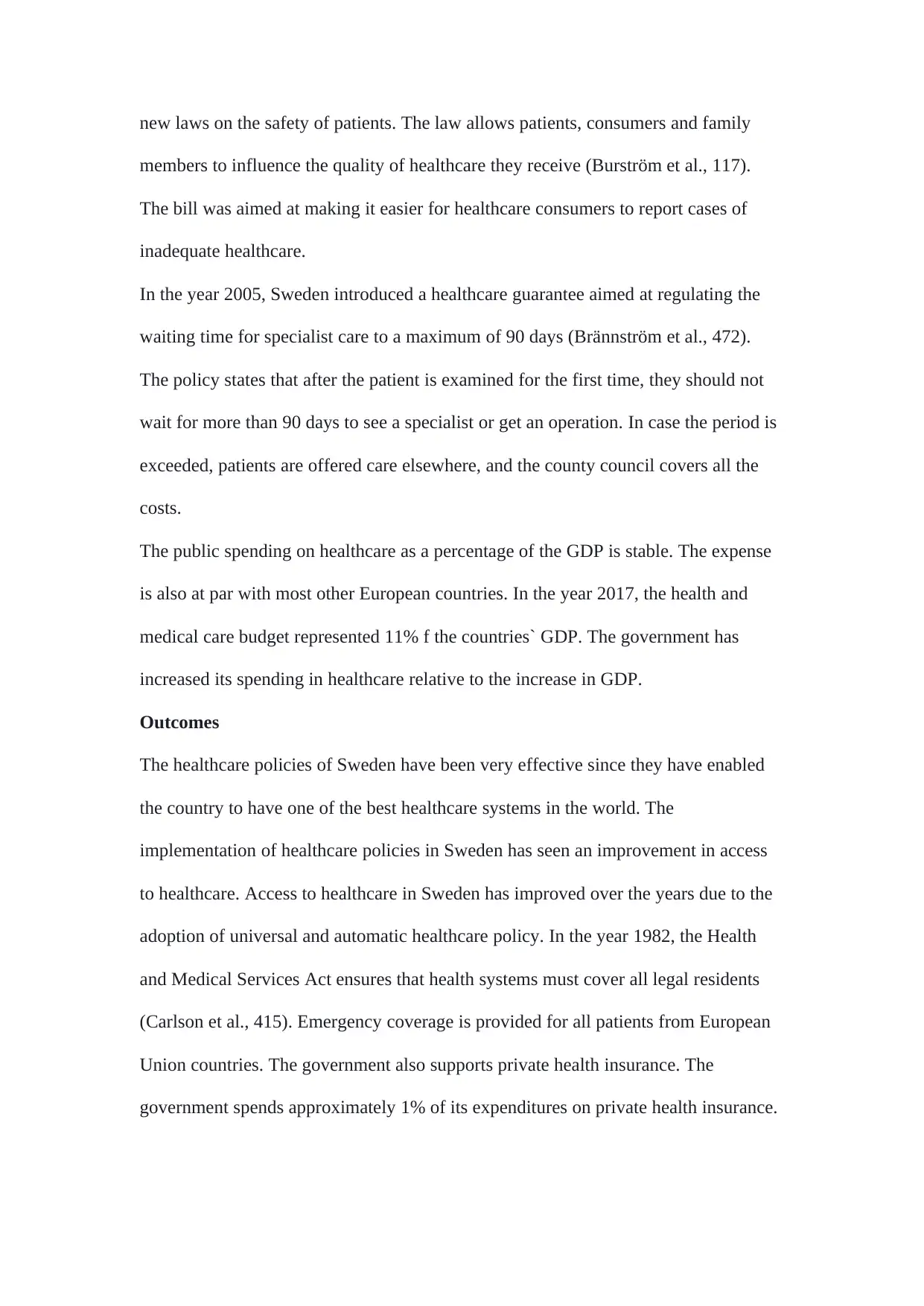
new laws on the safety of patients. The law allows patients, consumers and family
members to influence the quality of healthcare they receive (Burström et al., 117).
The bill was aimed at making it easier for healthcare consumers to report cases of
inadequate healthcare.
In the year 2005, Sweden introduced a healthcare guarantee aimed at regulating the
waiting time for specialist care to a maximum of 90 days (Brännström et al., 472).
The policy states that after the patient is examined for the first time, they should not
wait for more than 90 days to see a specialist or get an operation. In case the period is
exceeded, patients are offered care elsewhere, and the county council covers all the
costs.
The public spending on healthcare as a percentage of the GDP is stable. The expense
is also at par with most other European countries. In the year 2017, the health and
medical care budget represented 11% f the countries` GDP. The government has
increased its spending in healthcare relative to the increase in GDP.
Outcomes
The healthcare policies of Sweden have been very effective since they have enabled
the country to have one of the best healthcare systems in the world. The
implementation of healthcare policies in Sweden has seen an improvement in access
to healthcare. Access to healthcare in Sweden has improved over the years due to the
adoption of universal and automatic healthcare policy. In the year 1982, the Health
and Medical Services Act ensures that health systems must cover all legal residents
(Carlson et al., 415). Emergency coverage is provided for all patients from European
Union countries. The government also supports private health insurance. The
government spends approximately 1% of its expenditures on private health insurance.
members to influence the quality of healthcare they receive (Burström et al., 117).
The bill was aimed at making it easier for healthcare consumers to report cases of
inadequate healthcare.
In the year 2005, Sweden introduced a healthcare guarantee aimed at regulating the
waiting time for specialist care to a maximum of 90 days (Brännström et al., 472).
The policy states that after the patient is examined for the first time, they should not
wait for more than 90 days to see a specialist or get an operation. In case the period is
exceeded, patients are offered care elsewhere, and the county council covers all the
costs.
The public spending on healthcare as a percentage of the GDP is stable. The expense
is also at par with most other European countries. In the year 2017, the health and
medical care budget represented 11% f the countries` GDP. The government has
increased its spending in healthcare relative to the increase in GDP.
Outcomes
The healthcare policies of Sweden have been very effective since they have enabled
the country to have one of the best healthcare systems in the world. The
implementation of healthcare policies in Sweden has seen an improvement in access
to healthcare. Access to healthcare in Sweden has improved over the years due to the
adoption of universal and automatic healthcare policy. In the year 1982, the Health
and Medical Services Act ensures that health systems must cover all legal residents
(Carlson et al., 415). Emergency coverage is provided for all patients from European
Union countries. The government also supports private health insurance. The
government spends approximately 1% of its expenditures on private health insurance.
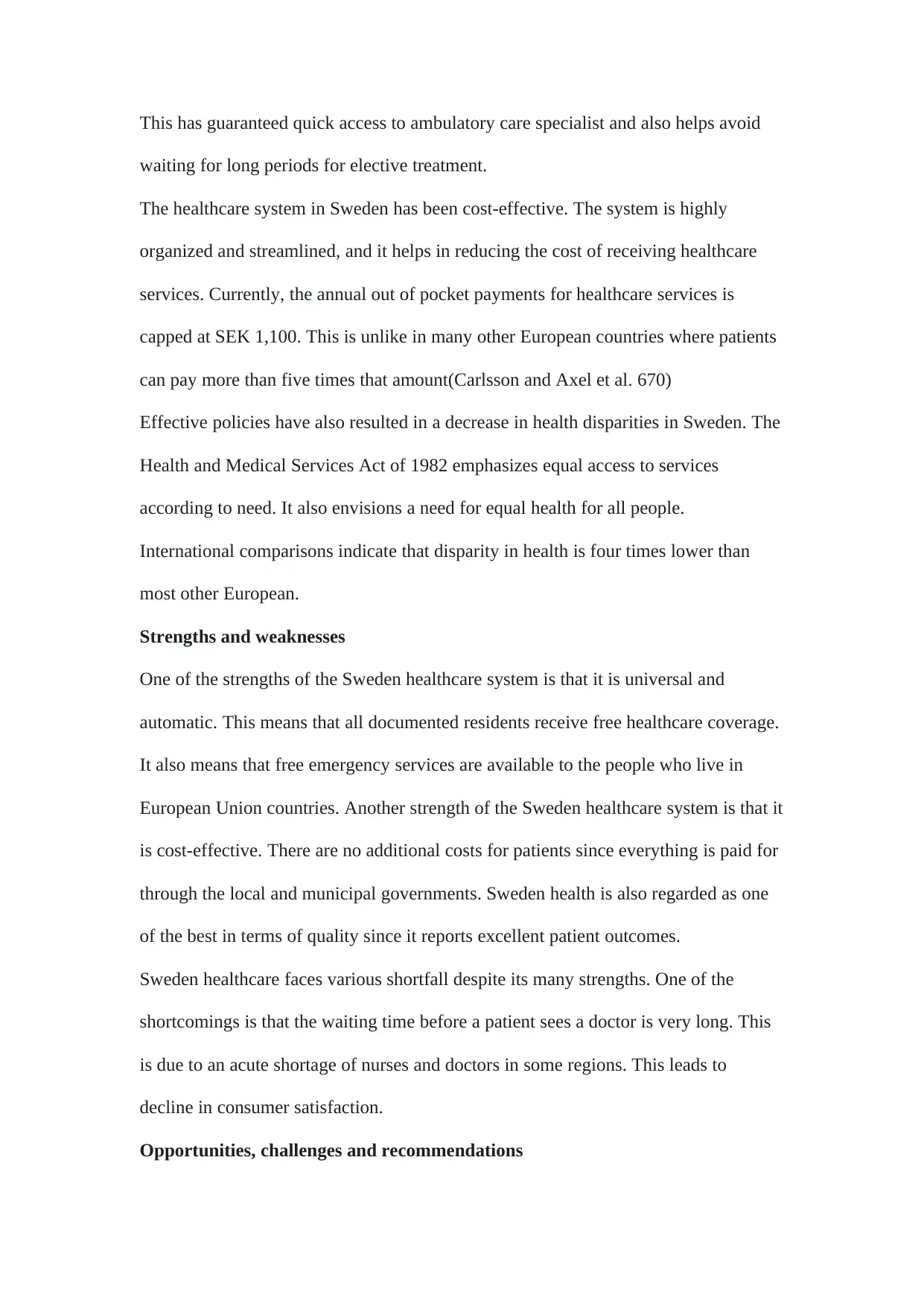
This has guaranteed quick access to ambulatory care specialist and also helps avoid
waiting for long periods for elective treatment.
The healthcare system in Sweden has been cost-effective. The system is highly
organized and streamlined, and it helps in reducing the cost of receiving healthcare
services. Currently, the annual out of pocket payments for healthcare services is
capped at SEK 1,100. This is unlike in many other European countries where patients
can pay more than five times that amount(Carlsson and Axel et al. 670)
Effective policies have also resulted in a decrease in health disparities in Sweden. The
Health and Medical Services Act of 1982 emphasizes equal access to services
according to need. It also envisions a need for equal health for all people.
International comparisons indicate that disparity in health is four times lower than
most other European.
Strengths and weaknesses
One of the strengths of the Sweden healthcare system is that it is universal and
automatic. This means that all documented residents receive free healthcare coverage.
It also means that free emergency services are available to the people who live in
European Union countries. Another strength of the Sweden healthcare system is that it
is cost-effective. There are no additional costs for patients since everything is paid for
through the local and municipal governments. Sweden health is also regarded as one
of the best in terms of quality since it reports excellent patient outcomes.
Sweden healthcare faces various shortfall despite its many strengths. One of the
shortcomings is that the waiting time before a patient sees a doctor is very long. This
is due to an acute shortage of nurses and doctors in some regions. This leads to
decline in consumer satisfaction.
Opportunities, challenges and recommendations
waiting for long periods for elective treatment.
The healthcare system in Sweden has been cost-effective. The system is highly
organized and streamlined, and it helps in reducing the cost of receiving healthcare
services. Currently, the annual out of pocket payments for healthcare services is
capped at SEK 1,100. This is unlike in many other European countries where patients
can pay more than five times that amount(Carlsson and Axel et al. 670)
Effective policies have also resulted in a decrease in health disparities in Sweden. The
Health and Medical Services Act of 1982 emphasizes equal access to services
according to need. It also envisions a need for equal health for all people.
International comparisons indicate that disparity in health is four times lower than
most other European.
Strengths and weaknesses
One of the strengths of the Sweden healthcare system is that it is universal and
automatic. This means that all documented residents receive free healthcare coverage.
It also means that free emergency services are available to the people who live in
European Union countries. Another strength of the Sweden healthcare system is that it
is cost-effective. There are no additional costs for patients since everything is paid for
through the local and municipal governments. Sweden health is also regarded as one
of the best in terms of quality since it reports excellent patient outcomes.
Sweden healthcare faces various shortfall despite its many strengths. One of the
shortcomings is that the waiting time before a patient sees a doctor is very long. This
is due to an acute shortage of nurses and doctors in some regions. This leads to
decline in consumer satisfaction.
Opportunities, challenges and recommendations
⊘ This is a preview!⊘
Do you want full access?
Subscribe today to unlock all pages.

Trusted by 1+ million students worldwide
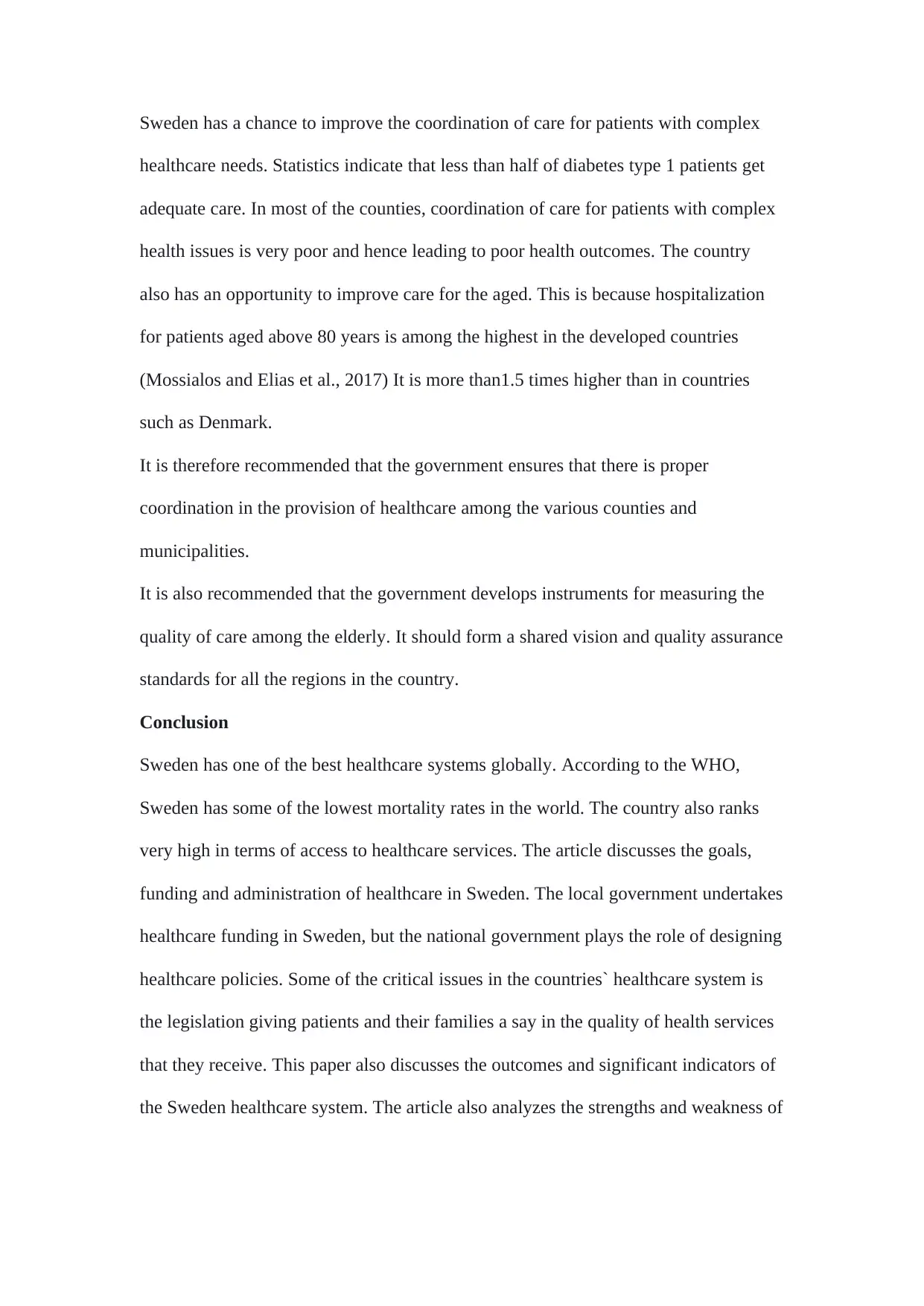
Sweden has a chance to improve the coordination of care for patients with complex
healthcare needs. Statistics indicate that less than half of diabetes type 1 patients get
adequate care. In most of the counties, coordination of care for patients with complex
health issues is very poor and hence leading to poor health outcomes. The country
also has an opportunity to improve care for the aged. This is because hospitalization
for patients aged above 80 years is among the highest in the developed countries
(Mossialos and Elias et al., 2017) It is more than1.5 times higher than in countries
such as Denmark.
It is therefore recommended that the government ensures that there is proper
coordination in the provision of healthcare among the various counties and
municipalities.
It is also recommended that the government develops instruments for measuring the
quality of care among the elderly. It should form a shared vision and quality assurance
standards for all the regions in the country.
Conclusion
Sweden has one of the best healthcare systems globally. According to the WHO,
Sweden has some of the lowest mortality rates in the world. The country also ranks
very high in terms of access to healthcare services. The article discusses the goals,
funding and administration of healthcare in Sweden. The local government undertakes
healthcare funding in Sweden, but the national government plays the role of designing
healthcare policies. Some of the critical issues in the countries` healthcare system is
the legislation giving patients and their families a say in the quality of health services
that they receive. This paper also discusses the outcomes and significant indicators of
the Sweden healthcare system. The article also analyzes the strengths and weakness of
healthcare needs. Statistics indicate that less than half of diabetes type 1 patients get
adequate care. In most of the counties, coordination of care for patients with complex
health issues is very poor and hence leading to poor health outcomes. The country
also has an opportunity to improve care for the aged. This is because hospitalization
for patients aged above 80 years is among the highest in the developed countries
(Mossialos and Elias et al., 2017) It is more than1.5 times higher than in countries
such as Denmark.
It is therefore recommended that the government ensures that there is proper
coordination in the provision of healthcare among the various counties and
municipalities.
It is also recommended that the government develops instruments for measuring the
quality of care among the elderly. It should form a shared vision and quality assurance
standards for all the regions in the country.
Conclusion
Sweden has one of the best healthcare systems globally. According to the WHO,
Sweden has some of the lowest mortality rates in the world. The country also ranks
very high in terms of access to healthcare services. The article discusses the goals,
funding and administration of healthcare in Sweden. The local government undertakes
healthcare funding in Sweden, but the national government plays the role of designing
healthcare policies. Some of the critical issues in the countries` healthcare system is
the legislation giving patients and their families a say in the quality of health services
that they receive. This paper also discusses the outcomes and significant indicators of
the Sweden healthcare system. The article also analyzes the strengths and weakness of
Paraphrase This Document
Need a fresh take? Get an instant paraphrase of this document with our AI Paraphraser
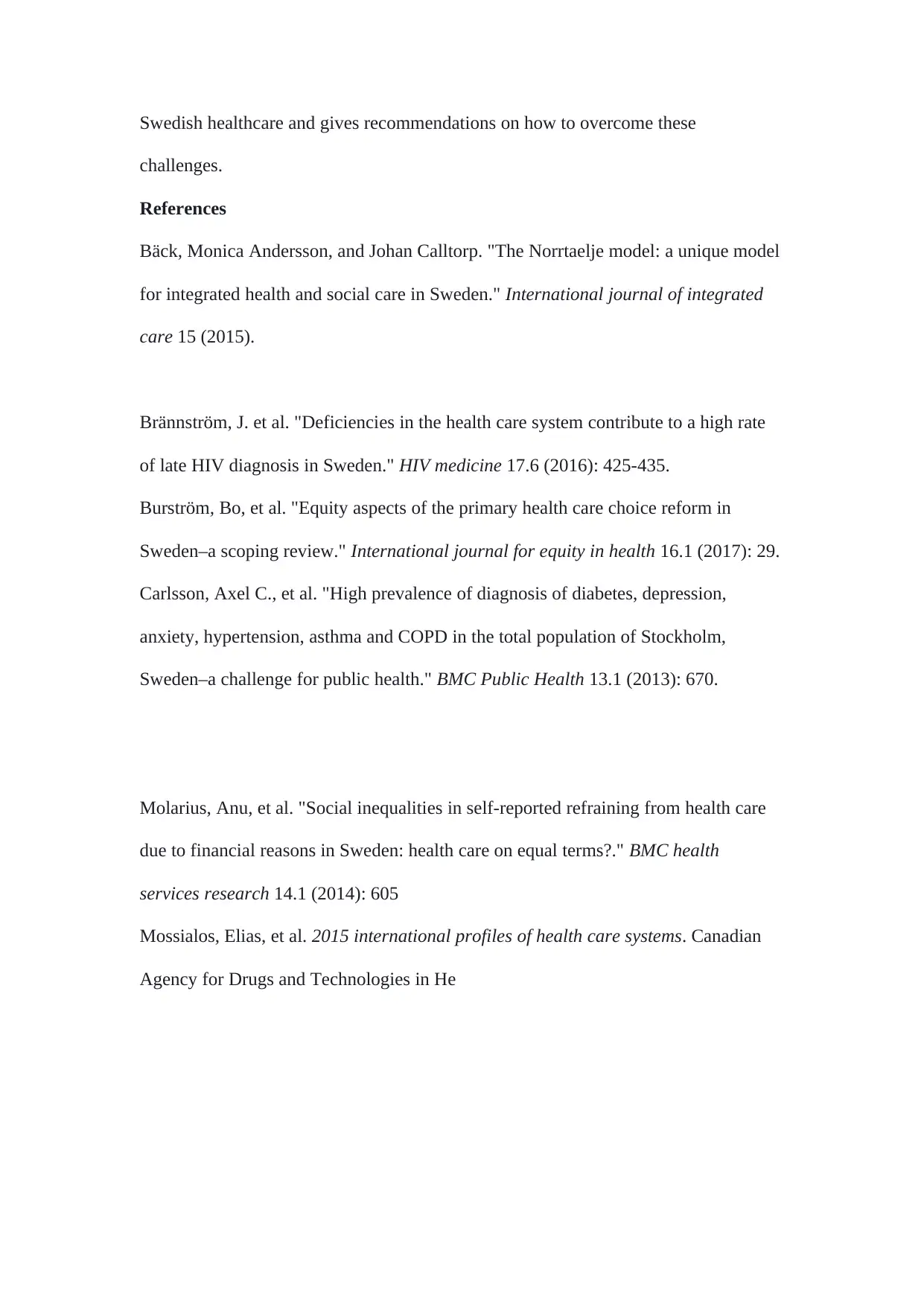
Swedish healthcare and gives recommendations on how to overcome these
challenges.
References
Bäck, Monica Andersson, and Johan Calltorp. "The Norrtaelje model: a unique model
for integrated health and social care in Sweden." International journal of integrated
care 15 (2015).
Brännström, J. et al. "Deficiencies in the health care system contribute to a high rate
of late HIV diagnosis in Sweden." HIV medicine 17.6 (2016): 425-435.
Burström, Bo, et al. "Equity aspects of the primary health care choice reform in
Sweden–a scoping review." International journal for equity in health 16.1 (2017): 29.
Carlsson, Axel C., et al. "High prevalence of diagnosis of diabetes, depression,
anxiety, hypertension, asthma and COPD in the total population of Stockholm,
Sweden–a challenge for public health." BMC Public Health 13.1 (2013): 670.
Molarius, Anu, et al. "Social inequalities in self-reported refraining from health care
due to financial reasons in Sweden: health care on equal terms?." BMC health
services research 14.1 (2014): 605
Mossialos, Elias, et al. 2015 international profiles of health care systems. Canadian
Agency for Drugs and Technologies in He
challenges.
References
Bäck, Monica Andersson, and Johan Calltorp. "The Norrtaelje model: a unique model
for integrated health and social care in Sweden." International journal of integrated
care 15 (2015).
Brännström, J. et al. "Deficiencies in the health care system contribute to a high rate
of late HIV diagnosis in Sweden." HIV medicine 17.6 (2016): 425-435.
Burström, Bo, et al. "Equity aspects of the primary health care choice reform in
Sweden–a scoping review." International journal for equity in health 16.1 (2017): 29.
Carlsson, Axel C., et al. "High prevalence of diagnosis of diabetes, depression,
anxiety, hypertension, asthma and COPD in the total population of Stockholm,
Sweden–a challenge for public health." BMC Public Health 13.1 (2013): 670.
Molarius, Anu, et al. "Social inequalities in self-reported refraining from health care
due to financial reasons in Sweden: health care on equal terms?." BMC health
services research 14.1 (2014): 605
Mossialos, Elias, et al. 2015 international profiles of health care systems. Canadian
Agency for Drugs and Technologies in He
1 out of 8
Related Documents
Your All-in-One AI-Powered Toolkit for Academic Success.
+13062052269
info@desklib.com
Available 24*7 on WhatsApp / Email
![[object Object]](/_next/static/media/star-bottom.7253800d.svg)
Unlock your academic potential
Copyright © 2020–2025 A2Z Services. All Rights Reserved. Developed and managed by ZUCOL.





